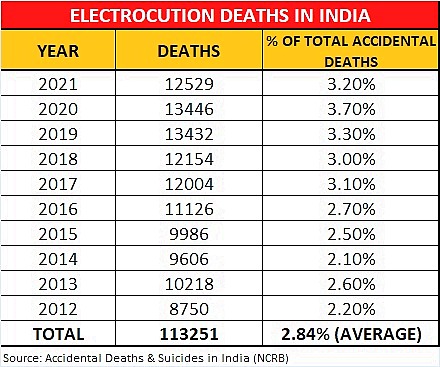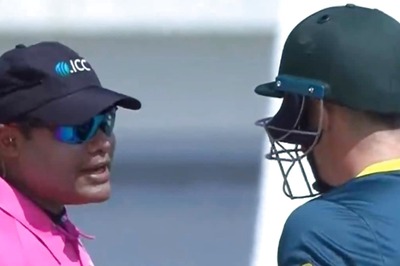
views
The recent multiple electrocution deaths have brought to the fore one of the major safety issues in India, especially during the monsoon season.
In the last week alone, at least 10 people have reportedly died from electric shocks. These incidents range from an accident outside the New Delhi Railway Station where a 34-year-old school teacher came in contact with an exposed wire to seven fatalities — including two children — due to electrocution during the Ulta Rath Yatra in Tripura’s Unakoti district. In both cases, a probe has been ordered to determine responsibility.
Although not widely discussed, electrocution deaths have been one of the major causes of accidental deaths in India, ranking just behind traffic accidents, drowning, poisoning, and falls.
A closer look at government data reveals the magnitude and peril of the issue that humans are exposed to every day in their lives. In the preceding 10 years until 2021, over 1.13 lakh people in India lost their lives due to fatal shocks.

In 2021, the latest year for which NCRB data is available, there were 12,529 deaths attributed to electrocution in the country, averaging 34 deaths per day. What adds to the concern is that both the number of deaths and their share in the total number of accidental deaths in the country are on the rise.
In 2012, 8,750 people lost their lives to electrical shocks in India. The figure rose by 54 per cent to 13,446 in 2020 before decreasing slightly to 12,529 in 2021. Similarly, the share of electrocution in total accidental deaths was 2.20 per cent in 2012, which increased to 3.70 per cent in 2020 before experiencing a slight decline in 2021. The decline could be attributed to the Covid-19-related shutdowns.
Among the states, Madhya Pradesh, for inexplicable reasons, continues to be the leading state for electrocution-related deaths. Between 2012 and 2021, 19,417 people in the state lost their lives to this menace. Despite comprising only 6.2 per cent of the Indian population, it accounted for over 17 per cent of the total deaths caused by electric current.
Maharashtra, Rajasthan, and Uttar Pradesh held the second, third, and fourth spots on this notorious list, with 14,086, 10,263, and 9,844 deaths respectively during the same period, according to government data.
The majority of those killed by electric shock in 2021 belonged to the 18 to 44 years age group. According to the data, 4,049 deaths were recorded in the 18-29 age group, while the death figure slightly exceeded that at 4,084 for the 30-44 age group. Together, these two age groups accounted for 65 per cent of the total deaths related to power injuries. Of the total deaths in the said year, over 85 per cent were male, while the remaining were female.
The concept of a modern society devoid of electricity is beyond comprehension. As electricity has become an integral part of human life, so have the risks and dangers associated with electric currents.
Extensive reliance on electricity in homes, offices, public spaces, and industries has resulted in a significant increase in the occurrence of deaths caused by fatal electric injuries. The presence of exposed wires in public spaces further exacerbates the danger, as seen in both the case of the Delhi teacher and the Tripura incident.
While explaining the danger posed by electric current, experts emphasise that one doesn’t necessarily need a 10,000-volt shock to be lethal.
“The current drawn by an electric appliance as tiny as a 7.5 W, 120-V lamp, passing from hand to hand or hand to foot across the chest, is sufficient to cause death by electrocution,” write researchers, quoting Daniel M. Fatovich, Professor of Emergency Medicine at Royal Perth Hospital, Western Australia, in a 2019 report in the Egyptian Journal of Forensic Sciences (EJFS).
The same paper, based on an analysis of electrocution deaths between 2012 and 2016 in central India, found that direct contact with a live electrical wire caused 22.72 per cent of the total deaths. It was followed by mishandling of an electric rod for water heating (18.1 per cent), contact with an overhead wire (15.9 per cent), using an evaporative water cooler (11.36 per cent), and interacting with electric switchboard (9.09 per cent).
Moreover, the high temperatures and humidity experienced during the summer and monsoon months result in excessive sweating. This, in turn, reduces the skin’s resistance to electric current.
Rainy season, according to the EJFS paper, accounted for the highest percentage of deaths at 38.6 per cent, followed by the summer season at 34.09 per cent, while 27.2 per cent of the cases occurred during the winter season.
In most of these cases, victims were in contact with water, the report concluded, attributing seasonal variations in electrocution-related deaths to “differences in humidity, moisture, and individual behaviour”.
Considering our ubiquitous exposure to electricity, it is crucial to exercise caution both in our homes and in social surroundings. It is advisable to avoid using old, defective, or damaged power appliances and overcrowded circuits. Regular inspections of home wiring and earthing by a trained professional are necessary at regular intervals. Additionally, children should be kept away from electrical appliances or gadgets that they are unable to handle.
Electric switchboards should always be installed at a height that makes them inaccessible to children. Power plugs should be removed before checking or repairing electrical gadgets. Always ensure that your hands are dry when touching appliances.
When outside our homes, it is advisable to avoid touching poles with any form of electric connection or venturing into areas with waterlogging during the monsoon season.
While carelessness can be fatal, exercising caution can protect us from deadly electric shocks which, experts warn, don’t even spare their makers if safety parameters are violated.

















Comments
0 comment